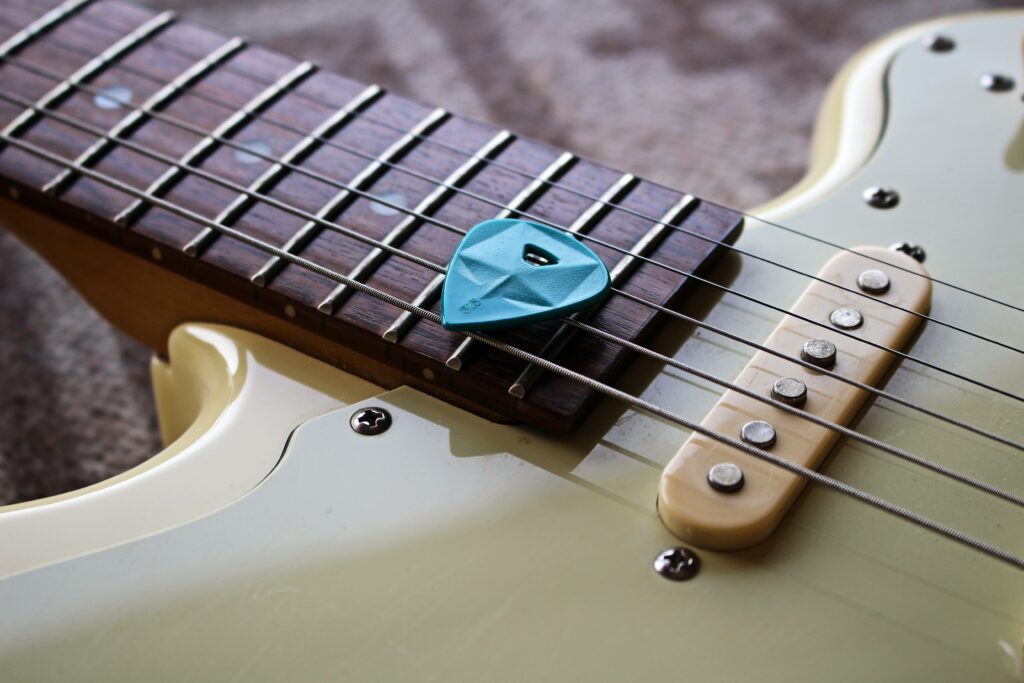
If you’re a guitarist, you know how important it is to have the right tools for the job. One of the most essential tools in a guitarist’s arsenal is the guitar pick. A guitar pick can drastically affect the tone and playability of your instrument, and choosing the right one can be a daunting task. In this article, we’ll discuss how to choose the perfect guitar pick for your playing style and preferences. We’ll cover important factors such as pick material, thickness, shape, and texture, and provide tips for finding the best pick for your needs. Whether you’re a beginner or a seasoned pro, selecting the right guitar pick can make all the difference in your playing. So let’s dive in and explore the world of guitar picks!
Different Types of Guitar Picks
When choosing a guitar pick, it’s important to consider the material and thickness, as well as the shape and texture of the pick’s surface. The thickness of the pick can affect the amount of control you have over your playing, while the shape and texture can influence the overall tone and feel of your playing. By experimenting with different types of picks, you can find the one that feels most comfortable and produces the sound you’re looking for.
Most Common Materials for Guitar Picks
Plastic picks are the most common type of guitar pick and come in a variety of shapes and thicknesses. They are widely available and offer a good balance of durability, flexibility, and affordability. The most popular plastic picks are made of celluloid, which has been used in the manufacturing of picks for over a century. They are known for producing a bright and snappy tone, making them a popular choice for many genres of music.
Nylon picks are similar to plastic picks in terms of flexibility and durability, but they tend to have a slightly softer feel. They are often used for playing acoustic guitar or for producing a more mellow sound on an electric guitar. Nylon picks can also be produced in a range of shapes and thicknesses to suit your playing style.
Metal picks are less common, but they offer a unique tonal quality that is popular with heavy metal or hard rock guitarists. Metal picks are typically made of brass, copper, or stainless steel and are much heavier and stiffer than plastic or nylon picks. They produce a bright and sharp tone, but they can be challenging to use for fast or intricate playing.
Felt picks are primarily used for playing acoustic guitar and are made of a soft and flexible material. They produce a mellow and warm tone and are favored by many acoustic guitarists for their ability to produce a softer sound that complements the natural tone of an acoustic guitar.
How to Hold a Guitar Pick
Learning how to hold a guitar pick is an essential skill for any guitarist, as it can greatly affect your playing technique and overall sound. There are two main methods for holding a guitar pick: the traditional method and the jazz method.
Traditional Method
The traditional method involves holding the pick between your thumb and index finger, with the tip of the pick facing towards the strings. The remaining three fingers are typically curled towards the palm of your hand. This method provides good stability and control over the pick, making it a popular choice for many guitarists.
Jazz Method
The jazz method, also known as the “pinch” method, involves holding the pick between the thumb and side of the index finger, with the tip of the pick facing downwards. The remaining three fingers are extended outwards. This method allows for greater flexibility and speed when playing, but can be more challenging to master.
Comparison of Traditional and Jazz Method
Both methods have their pros and cons. The traditional method provides more stability and control over the pick, making it easier to play complex chord progressions or strumming patterns. However, it can be less flexible and more difficult to play fast runs or arpeggios.
On the other hand, the jazz method allows for greater flexibility and speed when playing, making it easier to play fast runs and intricate melodies. However, it can be more difficult to maintain control over the pick, especially when playing at high speeds.
In conclusion, the method you choose for holding a guitar pick should ultimately depend on your personal playing style and the genre of music you’re playing. Whether you choose the traditional or jazz method, it’s important to practice consistently and experiment with different techniques to find the one that works best for you.
How to Hold a Guitar Pick for Sweep picking
Sweep picking is a technique used by many guitarists to play fast and intricate arpeggios. Holding the guitar pick properly is crucial to executing this technique accurately and efficiently.
To hold a guitar pick while sweep picking, use the traditional method by holding the pick between your thumb and index finger. However, instead of holding the pick perpendicular to the strings, tilt the pick slightly downwards towards the floor. This angle allows the pick to glide smoothly across the strings, producing a clean and fluid sound.
When sweep picking, it’s important to maintain a light grip on the pick and avoid tensing up your hand. This will help you maintain a smooth and consistent picking motion, allowing you to play complex arpeggios with ease.
Fingerstyle & Finger picking Guitar Picks
Fingerstyle guitar picks are a unique type of guitar pick that is designed to be used with a fingerpicking technique. These picks are usually made of plastic or nylon and are shaped like a small triangular piece with a curved edge.
One of the main advantages of using a fingerstyle guitar pick is that it allows for greater control and precision when playing complex fingerpicking patterns. The curved edge of the pick allows for a smooth and consistent attack on the strings, resulting in a clear and defined sound.
Another advantage of using a fingerstyle guitar pick is that it can reduce finger fatigue, making it easier to play for extended periods of time. This is especially beneficial for guitarists who regularly perform or record, as it can help prevent hand and finger injuries. Overall, fingerstyle guitar picks are a great option for guitarists who want to expand their playing technique and experiment with different tones and textures. With practice and experimentation, fingerstyle guitar picks can help you develop your fingerpicking skills and create a unique sound that’s all your own.

